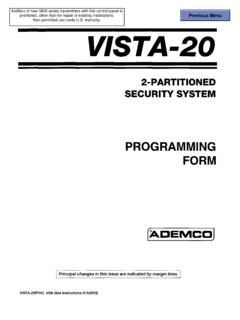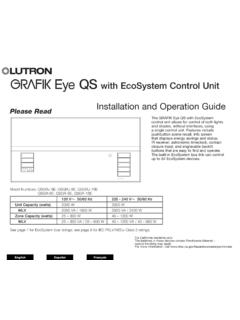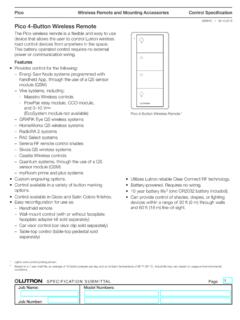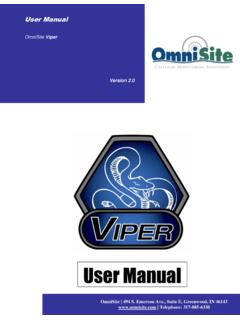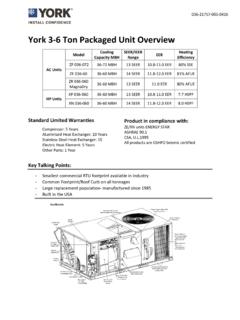Transcription of INSTALLATION No. 5816 INSTRUCTIONS - info-techs.com
1 Previous Menu For use with control panels only. CHANGES IN THIS ISSUE ARE INDICATED BY MARGIN LINES N6482V1 Rev. B 11/94. I N S TAL L ATI ON No. 5816. Door/Window I N S TR U CTI ON S Transmitter COVER PRY-OFF POINT. ALIGN MAGNET WITH. MARKS ON CASE AND. MAGNET ALIGNMENT STRIP A GUIDE ON MTG. PLATE. HOLES "A". (2) (SEE. +. BATTERY. CASE. HOLDING REED MAGNET. POSTS (2) SWITCH (OBTAIN. (INPUT 2) SEPARATELY). ANTENNA. PLATE.. MOUNTING COVER. TAMPER NOTE: HOLES (2). SWITCH 56161. 1/2" MAX. HAS 2. CONCEALED. WIRING UNIQUE. COVER LOOP. ENTRY ZONES.)
2 HOLDING TERMINALS. HOLE HOOKS (2) A (INPUT 1). CASE LOCKING TAB SLOT FOR CONCEALED. LOCKING RELEASE WINDOW WIRING ACCESS. TAB BREAKOUT FOR SURFACE WIRING ACCESS. Diagram 1. Mounting Plate Diagram 2. Transmitter, Cover Removed GENERAL INFORMATION 1. Remove the transmitter's cover by inserting the The No. 5816 Door/Window Transmitter has its own flat blade of a small screwdriver into the pry-off unique serial numbers permanently assigned during slot at the end of the unit farthest from the manufacture. The control unit is required to "learn" cover's decorative ribs, and twisting the blade.
3 The transmitter serial Nos. at 2. Disengage the supplied mounting plate from the some point prior to its usage in the alarm system. unit by inserting the blade of a small screwdriver Refer to the control unit's INSTALLATION INSTRUCTIONS for into the locking tab release window (see Di- further details. Note: During programming of the agram 2) and pressing it against the locking tab control unit, 5816 transmitters should be treated as (see Diagram 1) while sliding the plate downward "RF" ( supervised RF) Type (mandatory for UL along the case back.)
4 Installations ). 3. If a wired contact loop is to be used, with con- The 5816 has two unique zones; the first is for a cealed wiring, feed the wires through the con- wired cealed wiring entry hole at one corner of the closed circuit contact loop and the second for its mounting plate . built-in reed switch (used in conjunction with a mag- For surface wiring entry, a thin "breakout" area is net as described below). Either or both zones may provided in the case wall. Wiring can be run be used. For UL installations, a contact may not be through this breakout in the case when more than 3 feet from the transmitter.
5 Attaching the case in step 5. A built-in cover tamper switch is activated when the 4. Install the mounting plate, with its case holding cover is removed. posts pointing up (in this example), in the location selected as described in the control INSTALLATION unit's INSTALLATION INSTRUCTIONS . Use the flat head Mounting screws supplied. For proper orientation of the unit in relation to the 5. Attach the case back to the mounting plate by mounting plate, loop wiring, and/or magnet, read all sliding the keyhole slots in the case back down of this section before installing the unit.
6 Onto the mounting plate's case holding posts. The description that follows assumes that the unit The locking tab will click as the case back will be mounted as shown in the diagrams, with the locks in place. magnet (if used) located to the unit's right. The unit 6. If the unit's reed switch is to be used, a may, however, be installed in any direction, as long No. 5799 Magnet (obtain separately) should be as the relationship of the unit to its mounting plate mounted adjacent to the alignment marks on the and (if used) magnet is maintained.
7 Case and the mounting plate's alignment strip Although two holes are provided in the unit that (see Diagram 2). would permit mounting directly to a surface (holes 'A' Wiring Connections in Diagram 2), it is recommended that the mounting With the battery still not inserted, connect the plate be used, for ease in removing the unit for contact loop (if used) to the unit's loop terminals (see servicing should it become necessary. diagram). The contact loop must use closed circuit Before mounting the transmitter permanently, devices. The loop response time is a nominal conduct Go/No Go tests (see control's INSTRUCTIONS ) 100mSec.
8 To verify adequate signal strength and reorient or Note: If the contact loop is not to be used, no con- relocate the transmitter if necessary. nection is needed across its terminals. (continued). BATTERY INSTALLATION /REPLACEMENT SPECIFICATIONS. 1. Remove the transmitter's cover (if it is not al- Dimensions 1-9/16"W x 3-1/16"H x 1-3/16"D. ready off) as described in Mounting Step 1. (40mm x 78mm x 30mm). 2. Observe correct polarity and insert the battery Battery 3V Lithium (see Note in step 2 of provided into the battery holder (see Diagram 2).)
9 BATTERY INSTALLATION /REPLACEMENT). Take care not to bend the antenna. Note: Replace battery only with : BATTERY CAUTION: Risk of fire, explosion and burns. Do not recharge, disassemble, heat Panasonic CR123A, Duracell DL123A, above 212 F (100 C) or incinerate. Dispose of Sanyo CR123A, or Ademco 466. used batteries promptly. Keep away from 3. To replace the cover, engage the hooks along children. one edge and snap shut. TO THE INSTALLER. Regular maintenance and inspection (at least annually) by the installer and frequent testing by the user are vital to continuous satisfactory operation of any alarm system.
10 The installer should assume the responsibility of developing and offering a regular maintenance program to the user, as well as acquainting the user with the proper operation and limitations of the alarm system and its component parts. Recommendations must be included for a specific program of frequent testing (at least weekly) to insure the system's operation at all times. REFER TO THE INSTALLATION INSTRUCTIONS FOR THE. RECEIVER/CONTROL WITH WHICH THIS DEVICE IS USED, FOR. DETAILS REGARDING LIMITATIONS OF THE ENTIRE ALARM SYSTEM. ADEMCO LIMITED WARRANTY.



